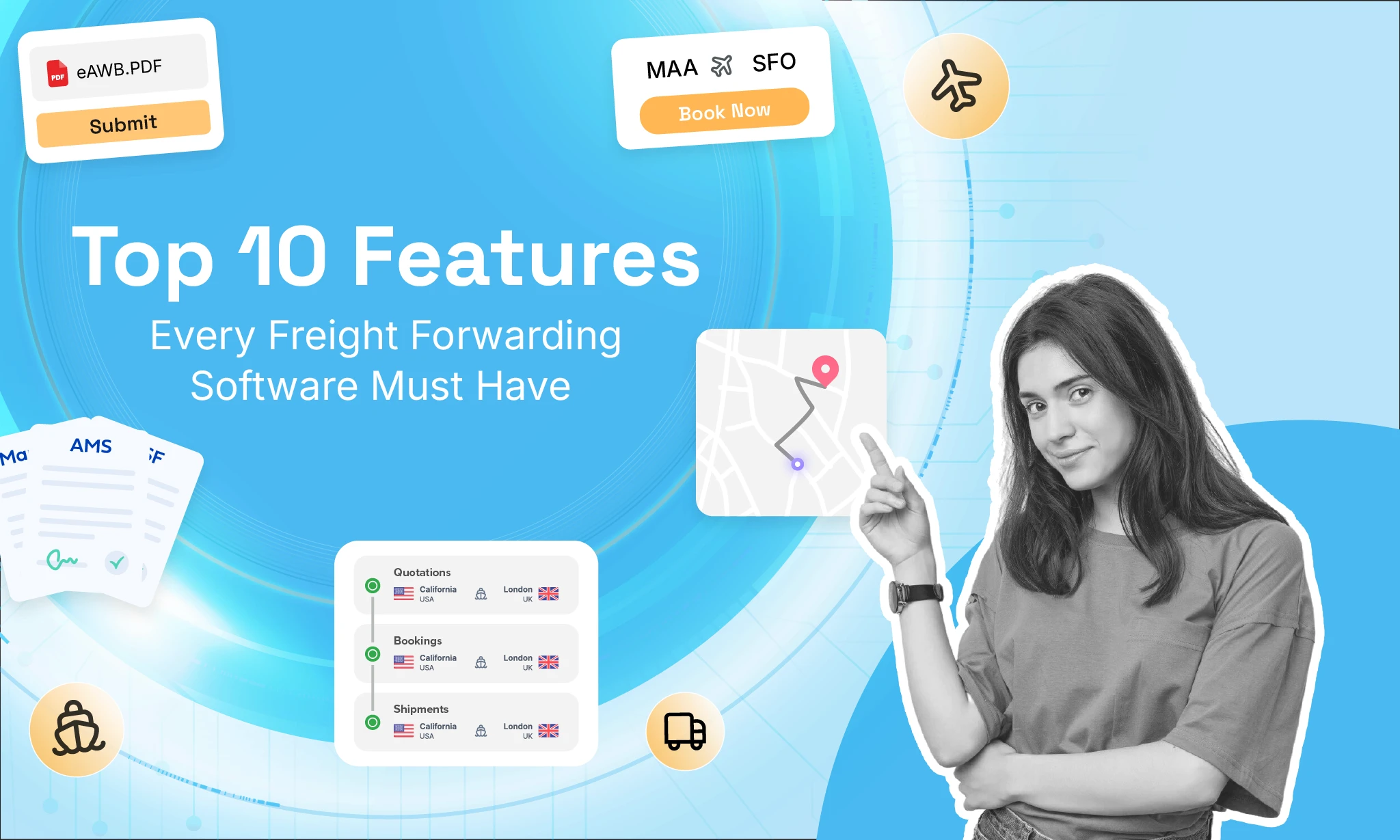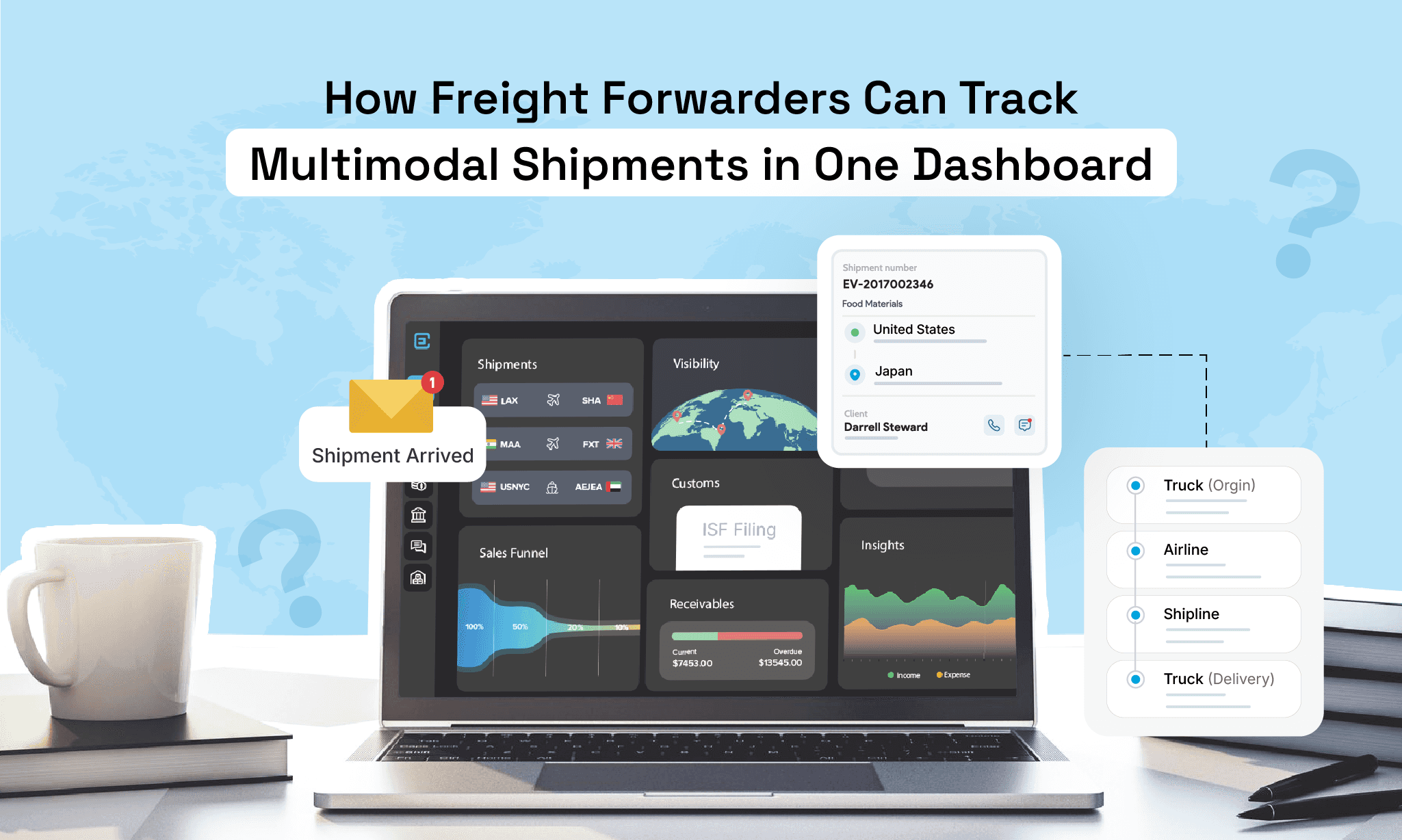KPIs in Freight Forwarding: 10 Metrics You Should Monitor
Author:
Divya Murugan
Published On:
Jul 28, 2025
Updated On:
Jul 28, 2025
1 min read
If you’re running freight forwarding operations, you know how crazy it gets. Multiple shipments, multiple carriers, dozens of parties involved. This is the nature of the logistics industry, where logistics management is key to procurement, transportation, storage, and delivery. And the constant pressure to be faster and cheaper. But how do you know if you’re doing it right?
That’s where KPIs come in.
Key performance indicators (KPIs) help you turn daily operations into measurable insights. In the logistics industry, logistics KPIs and other critical metrics are used to track and improve performance, customer satisfaction, and delivery efficiency. Without them, you’re flying blind. With the right metrics, you can identify delays, reduce costs, improve service, and build customer trust.
In this guide, we’ll walk you through the 10 most important freight forwarding KPIs you should be tracking, along with why they matter, how transportation data is used to monitor business operations, and how these metrics can drive better decision-making.
Key Takeaways
KPI tracking is key to improving freight forwarding operations
Tracking logistics KPI and reviewing logistics KPI examples – such as transportation, labor, financial,
and delivery metrics – helps identify areas for operational improvement and better decision making.Metrics like on-time delivery, transit time, and cost per shipment reveal service health and profitability* Monitor documentation and customs KPIs to reduce clearance delays.
A good carrier performance score helps you choose the right partners.
Consistent tracking builds customer trust and internal accountability
Why KPI Tracking Matters in Freight Forwarding

Freight forwarding is more than just booking containers or issuing bills of lading. It’s about optimizing every step of the shipment process while keeping customers informed and costs under control.
Tracking KPIs allows you to:
Make data-driven decisions
Spot performance issues early
Improve carrier relationships
Build transparency with customers
Stay competitive in a price-sensitive market
Use distribution metrics and metric measures to monitor and improve performance across freight forwarding operations and warehouse operations
Think of KPIs as your operations dashboard. When tracked consistently, they help you steer your business in the right direction. Tracking these metric measures and distribution metrics not only helps improve performance but also enables you to identify areas for optimization, ultimately leading to enhanced customer satisfaction.
Implementing KPI Tracking in Your Freight Forwarding Operations
Implementing KPI tracking in your freight forwarding operations is the foundation for continuous improvement and delivering exceptional customer satisfaction. Start by defining your business objectives-whether it’s reducing average freight cost, improving order accuracy, or increasing on-time deliveries. Once your goals are set, identify the most relevant logistics KPIs that align with your supply chain strategy. Next, set up a system to collect and analyze data. This could be as simple as a spreadsheet for smaller operations or a dedicated logistics metrics platform for larger freight forwarders. Logistics metrics scorecards are especially useful, providing a visual overview of key metrics like freight cost, order accuracy, and delivery performance. By tracking KPIs consistently, you gain insights into your supply chain and can make informed decisions, optimize processes, and improve overall business performance. Remember, the key to successful KPI tracking is not just collecting data but using it to drive meaningful improvements in your freight forwarding operations.
On-Time Delivery Rate
What is it: The percentage of shipments delivered on or before the promised date.
Why it matters: Delays hurt customer trust and often cost extra. Using reliable routes is key to maintaining high on-time delivery rates. Tracking this KPI helps you evaluate carrier performance and spot patterns in missed deadlines.
If your on-time delivery rate is dropping, it’s time to review carrier selection or investigate bottlenecks in customs or documentation.
Transit Time
What is it: The time it takes for a shipment to move from origin to destination.
Why it matters: Customers expect predictability. Monitoring delivery times is critical for logistics performance. Tracking average transit times helps you benchmark performance and compare carriers on more than just cost.
Shipment Accuracy
What is it: The percentage of shipments delivered without errors in quantity, documentation, or destination.
Why it matters: Incorrect deliveries lead to reverse logistics, unhappy customers, and extra costs. Shipment accuracy is also key to meeting supplier expectations as it shows you can deliver on time and maintain high performance standards. This KPI reflects the quality of your operations team and data accuracy.
Cost per Shipment
What is it: The total cost to move one shipment, including freight charges, handling, documentation, shipping costs, transportation costs, and other surcharges.
Why it matters: It helps you monitor profitability and pricing strategies. Monitoring average margin is critical to understanding overall profitability and making informed decisions. If the cost per shipment increases without a corresponding service upgrade, your margins may be under pressure.
Freight Bill Accuracy
What is it: The percentage of freight invoices that match the quoted or agreed-upon rates.Why it matters: Inaccurate billing causes revenue leakage and customer disputes. Accurate billing is also key to managing relationships with freight carriers as it enables better evaluation and benchmarking of carrier agreements. This KPI highlights errors in rate management or system configuration.
Customer Satisfaction and Complaint Rate
What is it: Number of complaints per 100 or 1,000 shipments.
Why it matters: It’s a direct measure of customer satisfaction. Issues with delivery services are a common source of customer complaints, especially as they are the final step in the supply chain. Complaints can range from missing documents to unclear communication. Tracking them reveals patterns you can address.
Carrier Performance Score
What is it: A composite score based on carrier-specific KPIs like on-time delivery, communication, issue resolution, and billing accuracy.
Why it matters: Carrier performance data allows you to advise clients on the best shipping options, ensuring cost-effective and reliable deliveries. A performance score helps you build a reliable carrier pool based on data, not just rates, especially when combined with real-time tracking capabilities.
Container Utilization
What is it: Percentage of space used within a container relative to its total capacity. Capacity utilization in this context means how efficiently the available container space is being used to maximize operational efficiency and control costs.
Customs Clearance Time
What is it: Average time taken for shipments to clear customs in the origin and destination countries.
Why it matters: Delays at customs can disrupt schedules and cost money. Customs clearance time is part of overall lead time, directly affecting the order cycle from placement to receipt. This KPI helps evaluate documentation accuracy and broker efficiency.
Document Processing Time
What is it: Time taken to prepare and share key shipping documents like invoices, HBL/MBL, packing lists, and certificates.
Why it matters: Faster documentation means quicker dispatches and fewer last-minute errors. Document processing time is a key indicator of process efficiency as it directly impacts delivery time and overall operational performance. This KPI is a direct reflection of internal efficiency.
Monitoring and Analyzing KPIs:

Logistics Metrics Scorecards: Logistics metrics scorecards are a powerful tool for monitoring and analyzing KPIs in the freight forwarding industry. These scorecards allow freight forwarders to see their performance across key areas such as inventory accuracy, warehouse space utilization, and on-time delivery. By consolidating key metrics into one dashboard, scorecards make it easy to compare your logistics operations against industry benchmarks and spot areas that need attention.
With a well-designed scorecard, you can track trends in delivery performance, identify fluctuations in space utilization, and see how your freight forwarders are performing over time. This level of visibility helps you pinpoint bottlenecks, address inefficiencies, and implement targeted improvements to your supply chain management. For example, if your scorecard shows a dip in on-time delivery, you can investigate the root cause – whether it’s a specific carrier, rout,e or process – and take corrective action to improve your logistics performance. Ultimately, logistics metrics scorecards enable you to make data-driven decisions to keep your freight forwarding operations running smoothly and competitively.
Best Practices for KPI Tracking in Freight Forwarding

To get the most out of KPI tracking in freight forwarding, you need to follow a set of best practices that ensure your efforts are effective and aligned to your business goals. Start by setting clear objectives and selecting logistics KPIs that truly reflect your priorities, such as average freight cost, inventory turnover ratio and delivery time. Establish a robust system for collecting and analyzing data and use logistics metrics scorecards to monitor your progress and highlight areas for improvement.
Review and update your KPIs regularly to keep pace with changes in the freight forwarding industry and your business model. Stay informed about industry trends such as changes in freight costs or advances in transportation management and use data analytics to optimize your logistics operations. By tracking key metrics and adjusting your strategies accordingly you can improve logistics performance, customer satisfaction and stay competitive. Remember, KPI tracking is an ongoing process – one that helps you reduce costs incurred, boost supply chain efficiency, and deliver value to your customers.
Conclusion
Freight forwarding is a high-speed business. Without clear metrics, it’s hard to know what’s working and what’s not.
Start with a simple KPI dashboard. Track trends month on month. Talk to your team about what these numbers mean. And most importantly, act on them.
Because in logistics, what gets measured can be improved. And what gets improved moves your business forward.
Frequently Asked Questions (FAQs)
1. How often should freight forwarding KPIs be tracked?
Core KPIs like on-time delivery and cost per shipment should be monitored weekly or monthly. For larger businesses, real-time dashboards can provide ongoing visibility.
2. What tools are used to track KPIs in freight forwarding?
Modern freight software and transportation management systems often come with built-in KPI dashboards. You can also use ERP tools, spreadsheets or BI platforms like Power BI or Tableau.
3. How can I improve on-time delivery rates?
Start by analyzing delay patterns. Are they caused by specific carriers, routes, or documentation errors? Address root causes with better planning, reliable partner,s and digitized workflows.
4. What is the most important KPI in freight forwarding?
While this depends on your business goals, on-time delivery rate and cost per shipment are the most common. They impact both customer satisfaction and your bottom line.
5. Should I share KPIs with customers?
Yes, especially if you offer managed logistics or 3PL services. Sharing performance metrics builds transparency and shows you’re committed to continuous improvement.
Don't forget to share this blog!



